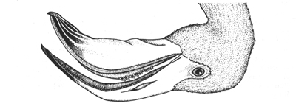|
Flamingos are filter feeders, and in that respect resemble whales and oysters more than they do most birds. Many complex rows of horny plates line their beaks, plates that, like those of baleen whales, are used to strain food items from the water. The filter of the Greater Flamingo traps crustaceans, mollusks, and insects an inch or so long. The Lesser Flamingo has such a dense filter that it can sift out single-celled plants less than two hundredths of an inch in diameter.
Flamingos feed with their heads down, and their bills are adapted accordingly. In most birds a smaller lower beak works against a larger upper one. In flamingos this is reversed; the lower bill is much larger and stronger, and the fat tongue runs within the bill's deep central groove. To complete the jaw reversal, unlike other birds (and mammals) the upper jaw is not rigidly fixed to the skull. Consequently, with the bird's head upside down during feeding the upper bill moves up and down, permitting the flamingo's jaws to work "normally." Part of the flamingo's filter feeding is accomplished simply by swinging the head back and forth and letting the water flow through the bill. The tongue also can be used as a pump to pass water through the bill's strainer more efficiently. It moves quickly fore and aft in its groove, sucking water in through the filter as it pulls backward, and expelling it from the beak as it pushes forward. The tongue may repeat its cycle up to four times a second. Flamingos are not the only avian filter feeders, however. Some penguins and auks have simple structures to help them strain small organisms from water, and one Southern Hemisphere genus of petrels (Pachyptila, prions or whalebirds) and some ducks have filtering devices. The Northern Shoveler, the most highly developed filter feeder among the ducks, has specialized plates lining its long, broad bill. The Mallard also has a broad bill, horny plates, and an enlarged tongue. But the pumping action of the ducks is different, and their tongues are housed in the upper mandible, rather than in the lower as in the flamingos. The flamingo's marvelously adapted tongue almost became its downfall. Roman emperors considered it a delicacy and were served flamingo tongues in a dish that also included pheasant brains, parrotfish livers, and lamprey guts. Roman poets decried the slaughter of the magnificent birds for their tongues (much as early American conservationists lamented the slaughter of bison for theirs). One poet, Martial, wrote (as Stephen Jay Gould recently translated): My red wing gives me my name, but epicures regard my tongue as tasty. SEE: Determining Diets; Shorebird Feeding; Bills. Copyright ® 1988 by Paul R. Ehrlich, David S. Dobkin, and Darryl Wheye. |
